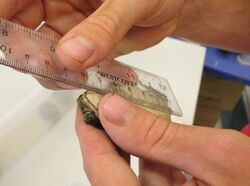Snout–vent length

Snout–vent length (SVL) is a morphometric measurement taken in herpetology from the tip of the snout to the most posterior opening of the cloacal slit (vent).[1] It is the most common measurement taken in herpetology, being used for all amphibians, lepidosaurs, and crocodilians (for turtles, carapace length (CL) and plastral length (PL) are used instead). The SVL differs depending on whether the animal is struggling or relaxed (if alive), or various other factors if it is a preserved specimen.[2] For fossils, an osteological correlate such as precaudal length must be used. When combined with weight and body condition, SVL can help deduce age and sex.[3]
Advantages
Because tails are often missing or absent, especially in juveniles, SVL is seen as more invariant than total length. Even in the case of crocodiles, tail tips may be missing.[4]
Methods
The measurements may be taken with dial calipers or digital calipers.
Various devices are used to position the animal while the measurement is being taken, such as a snake tube, "Mander Masher",[5] or a "Salamander Stick".[6]
References
- ↑ "direct line distance from tip of snout to posterior margin of vent" Watters, Jessa L.; Cummings, Sean T.; Flanagan, Rachel L.; Siler, Cameron D. (2016). "Review of morphometric measurements used in anuran species descriptions and recommendations for a standardized approach". Zootaxa 4072 (4): 477–495. doi:10.11646/zootaxa.4072.4.6. ISSN 1175-5334. PMID 27395941.
- ↑ Vitt, Laurie J.; Zug, George R. (2012). Herpetology: An Introductory Biology of Amphibians and Reptiles. Academic Press. p. 34. ISBN 978-0127826202. https://books.google.com/books?id=nqgpcru2sfwC&q=snout-vent+length&pg=PA318.
- ↑ Kupfer, A.. "Sexual size dimorphism in amphibians: an overview". in Fairbairn, D. J.; Blanckenhorn, W. U.; Székely, T.. Sex, Size, and Gender Roles: Evolutionary Studies of Sexual Size Dimorphis. New York: Oxford University Press. pp. 50–59.
- ↑ Bolton, Melvin (1989). "7. Capture, Transport, Marking and Measuring of Young Crocodiles". The management of crocodiles in captivity. FAO. http://www.fao.org/3/T0226E/t0226e08.htm.
- ↑ Wise, S. E.; Buchanan, S. W. (1992). "An efficient method for measuring salamanders". Herpetological Review 23: 56–57.
- ↑ Walston, L. J.; Mullin, S. J. (2005). "Evaluation of a new method for measuring salamanders". Herpetological Review 36: 290–292.
Further reading
- Jessica L. Deichmann; William E. Duellman; G. Bruce Williamson (June 2008). "Predicting Biomass from Snout–Vent Length in New World Frogs". Journal of Herpetology 42 (2): 238–245. doi:10.1670/07-0731.1.
- Richard W. Blob (August 1998). "Evaluation of Vent Position from Lizard Skeletons for Estimation of Snout–Vent Length and Body Mass". Copeia 1998 (3): 792–801. doi:10.2307/1447817.
- Allen E. Greer; Lisa Wadsworth (September 2003). "Body Shape in Skinks: The Relationship between Relative Hind Limb Length and Relative Snout–Vent Length". Journal of Herpetology 37 (3): 554–559. doi:10.1670/138-02N.
 |
